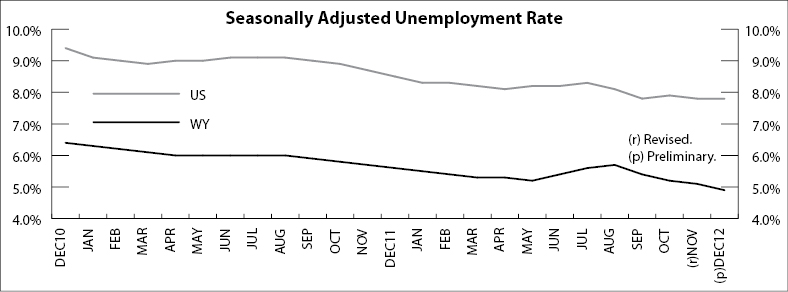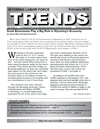Wyoming Unemployment Rate Falls to 4.9% in December 2012
The Research & Planning section of the Wyoming Department of Workforce Services has reported that the state's seasonally adjusted1 unemployment rate decreased from 5.1% in November to 4.9% in December (not a statistically significant change). Wyoming unemployment was down from its year-ago level of 5.6% and significantly lower than the current U.S. rate of 7.8%. Seasonally adjusted employment of Wyoming residents decreased by 284 individuals (-0.1%) from November to December. The number of unemployed individuals in Wyoming has fallen while employment has not grown, causing the state's labor force to decline. From December 2011 to December 2012, Wyoming's labor force decreased by 2,455 individuals (-0.8%).
Most county unemployment rates changed very little from November to December. Teton County's unemployment rate followed its normal seasonal pattern and fell from 9.7% to 7.3% as the winter tourist season started.
The highest unemployment rates were found in the western and central parts of the state. Teton County posted the highest unemployment rate (7.3%) followed by Lincoln (7.0%), Fremont (6.2%), and Park (5.9%) counties. The lowest unemployment rates were found in Sublette (3.6%), Converse (3.7%), and Niobrara (3.8%) counties.
Most county unemployment rates decreased from December 2011 to December 2012. The largest decreases occurred in Lincoln (down from 8.1% to 7.0%), Natrona (down from 5.4% to 4.4%), and Johnson (down from 6.6% to 5.6%) counties. Unemployment rates increased in Sublette (up from 3.1% to 3.6%), Hot Springs (up from 4.6% to 5.0%), and Campbell (up from 4.1% to 4.2%) counties.
Total nonfarm employment in Wyoming (measured by place of work) stood at 284,600 jobs in December 2012, unchanged from a year earlier.
1Seasonal adjustment is a statistical procedure to remove the impact of normal regularly recurring events (such as weather, major holidays, and the opening and closing of schools) from economic time series to better understand changes in economic conditions from month to month.

